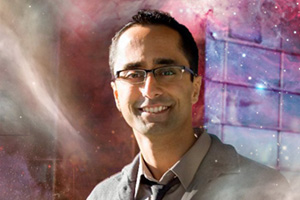University's Rupinder Brar primed for August 21 solar eclipse
Astrophysicist explains what you need to know about rare celestial event
August 8, 2017

Perhaps surprisingly, solar eclipses are not a particularly rare occurrence. In fact, they happen at least twice (and sometimes as many as five times) a year. Most eclipses of the sun are partial. However, total solar eclipses, where the moon completely covers the disk of the sun, occur less frequently―about once every 18 months.
On Monday, August 21, much of North America will be able to observe a partial solar eclipse. If you are lucky enough to be within a narrow 110-kilometre wide swath in the United States that day, you could witness the total solar eclipse.
-
Quick fact: On average, a total solar eclipse is observable from any single spot on the planet just once every 375 years.
Observed from the Greater Toronto Area, the (invisible) new moon crossing directly in front of sun on the afternoon of August 21 will temporarily block it (up to 75 per cent). The sun will look much like a cookie with a big bite taken out of it.
You must have proper eye protection to view the eclipse safely. Looking directly at the sun can cause serious eye damage or blindness.
University of Ontario Institute of Technology Astrophysicist Rupinder Brar, PhD, often explains the complexities of celestial events. Dr. Brar says there is much we can learn on August 21.
How is a solar eclipse created?
Dr. Brar: When the path of the moon orbiting the Earth crosses directly in front of the sun, the moon casts its shadow on Earth. Eclipses occur where that shadow is observable. If the moon completely blocks the sun’s disk, you observe a total solar eclipse. With the disk blocked, the sun’s atmosphere (called the corona) becomes visible. The observation is particularly stunning.
Why don’t solar eclipses happen every lunar cycle?
Dr. Brar: The orbital plane of the moon around the Earth tilts slightly when compared to the plane of Earth’s orbit around the sun. Eclipses can happen only when those two orbital planes intersect, at the same time the moon is between the Earth and sun.
Can I see an eclipse from anywhere?
Dr. Brar: Each solar eclipse can only be seen from a small area of the Earth. With oceans making up 70 per cent of the planet’s surface, most solar eclipses are not visible from populated areas.
Are solar eclipses random?
Dr. Brar: No. We can calculate when and where they will happen, as well as when they happened in the past. It is a beautiful, random quirk that we can see eclipses at all. The sun is about 400 times bigger than the moon, and it is about 400 times further away from Earth. This makes the sun and the moon appear roughly the same size in the sky when viewed from Earth.
Are there any special events happening?
Dr. Brar: There are a number of special events in Toronto. A key one might be from the Royal Astronomical Society Toronto Centre. Locally, science buffs should monitor any possible activity that Durham Region Astronomical Association might be planning. Those wanting to take in the full total eclipse experience would need to travel to the central United States to find a spot on the path of totality (eclipse2017 interactive map shows exact locations)
Where can I get the proper eye protection tools?
Dr. Brar: It is very important to take proper safety precautions when looking at a solar eclipse. Looking directly at a solar eclipse can cause permanent damage to eyes. The only safe way to look at a solar eclipse is through inexpensive solar eclipse glasses, through a solar telescope or one with a solar filter, or observe it through a homemade pinhole camera.
NASA information links:
- NASA Eclipse Safety
- NASA How to Make a Pinhole Camera
When was the last total solar eclipse in Ontario?
Dr. Brar: On January 24, 1925, the path of totality of a solar eclipse passed over the City of Toronto. The path stretched from Scarborough to London and included centres like Kitchener, Hamilton and Niagara Falls.
Some people may remember the annular solar eclipse of May 10, 1994 as well. It was spectacular but not a total solar eclipse because some of sun’s disk was visible around the moon, due to the moon being farther from the Earth in its orbit, thus making it appear a bit smaller than the sun.
Will there be a total solar eclipse in Ontario in the future?
Dr. Brar: Yes. On April 8, 2024, the path of totality during a solar eclipse will pass just to the south of Oshawa. On that occasion, the moon will block about 99 per cent of the sun. Totality will occur along the north shore of Lake Erie (including Port Colborne and Fort Erie), and south of Lake Ontario in Western New York.
Media contact
Bryan Oliver
Communications and Marketing
Ontario Tech University
905.721.8668 ext. 6709
bryan.oliver@uoit.ca



